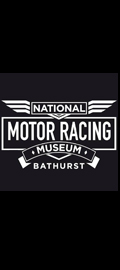
|
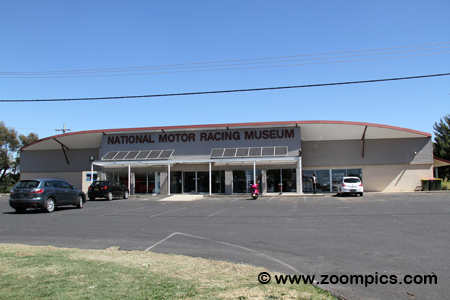
|
Australia’s National Motor Racing Museum opened at Mount Panorama in 1988 through the efforts of the Bathurst Light Car Club.
It was initially called the Mount Panorama Hall of Fame and concentrated on the history of the local circuit.
In 1997, the Bathurst Regional Council took over management of the museum and the focus shifted to include all aspects
of Australian motorsport. It now houses historically significant racing vehicles.
|

|
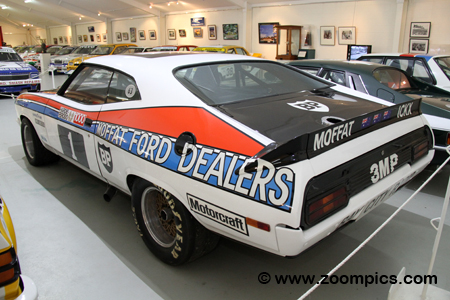
|
This Ford Falcon XC won the 1977 Bathurst 1000.
Sharing the driving was the team owner, Allan Moffat and Jacky Ickx.
The Moffat Team entered two the Fords during the 1977 season.
Driving the second car were Allan Hamilton and former Holden Dealer Team competitor, Colin Bond.
The team proved to be formidable winning six, of eight-rounds and finishing first and second in five of these races.
Bathurst was another one-two result.
|

|
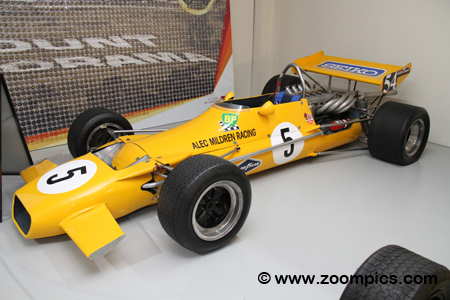
|
Formula One designer, Len Bailey, penned this racer.
The car is called the Mildren and was commissioned by Alec Mildren.
It was built specifically for the Tasman Series.
Dubbed ‘The Yellow Submarine,’ the Mildren made its debut in January 1969 at Pukekohe in the hands of Frank Gardner.
The Mildren was originally equipped with a 2.5-liter Alfa Romeo engine and later replaced with an Australian 2.0-liter Waggott motor.
|

|

|
Mike Walker built this drag bike.
Walker was a successful engine tuner that decided to develop his own power-plant in 1975.
The MW Special was constructed around the motor which, started as a solid block of metal.
The result was a 2-liter 90-degree V-twin fitted with a four-camshaft cylinder head.
The final product produced approximately 300-horsepower and competed for over 30-years.
|

|
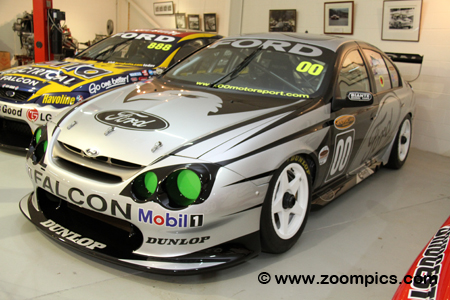
|
This 2001 Ford Falcon AU V8 Supercar was named ‘The Green-Eyed Monster’ by fans as the result of its green headlight covers.
Gibson Motorsport entered in the 2001 for the Bathurst 1000. Neil Crompton and Craig Lowndes shared the car.
The duo did not fare very well. Caught out by unexpected hail, the Ford slid off the track and was classified seventeenth.
The following year, the car retired after overheating.
|

|
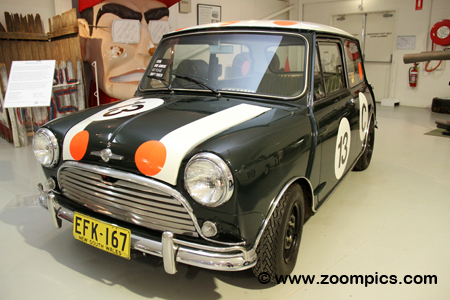
|
This 1966 Morris Cooper S is a replica of the car that won the Gallaher 500.
Bob Holden and Rauno Aaltonen drove the original vehicle. The top-9 finishers all drove a Cooper S.
The project to reproduce this unique Mini started in 1994 and was undertaken by the Bathurst Regional Council Workshop.
The staff took the car down to the bare metal and all mechanical components were reconditioned. The Mini was completed in 1996.
|

|
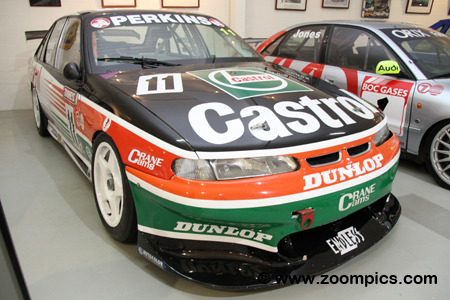
|
Larry Perkins and Russell Ingall drove this Commodore VR to victory in the 1995 Tooheys 1000.
During the event, Perkins and Ingall completed the nearly impossible task of starting at the back of the field and driving to the win.
On the opening lap, Perkins and Craig Lowndes made contact, causing a flat tire on the Commodore.
They made progress and inherited positions as the leaders dropped out. At the checker, the duo was in first.
|

|
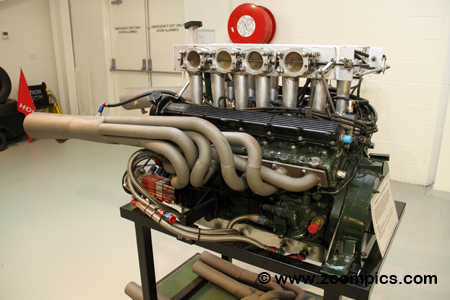
|
This is a Jaguar V12 6-litre fuel-injected engine. It was built and raced by Barry Sharp.
Sharp used the motor in a racing boat called JAG.
The power-plant produced 636-horsepower and achieved a top speed of 101-mph.
JAG was a successful watercraft winning two Deepwater Motor Boat Club 6-liter Fuel Injected Displacement races,
one Unlimited Unrestricted contest and one Open Class event.
|

|
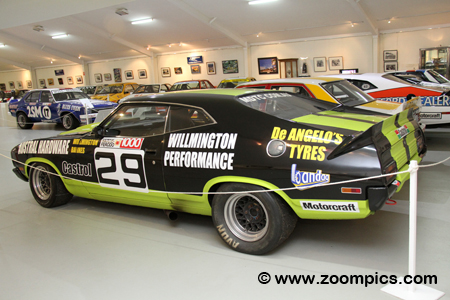
|
Privateer, Garry Willmington entered this Ford Falcon XC GS500 Hardtop in the 1978 Hardie-Ferodo 1000.
Sharing the car with Willmington was Jeff Barnes. It was not a successful race for the pair.
They finished twenty-third overall. Willmington would compete at Bathurst from 1978 to 2000 – winning his class in 1987.
After he retired from competing in race cars, Willmington managed Wakefield Park Raceway.
|

|
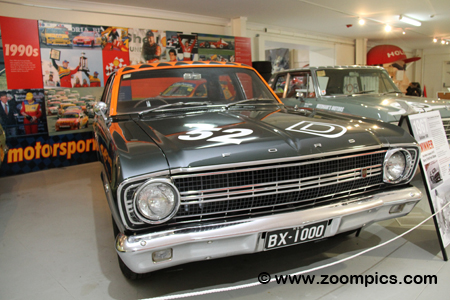
|
In May 1967, Ford Australia introduced the XR GT Falcon. Seven of these new models were entered in the Gallaher 500.
The Falcons were fitted with a 4.7-liter V8 engine using a Holley four-barrel carburetor.
The maximum speed was claimed to be 190 km/hr. At Mount Panorama, they eclipsed last year’s quickest time by over 5-seconds.
Needless to say, they won - the first place drivers were, Harry Firth and Fred Gibson.
|

|
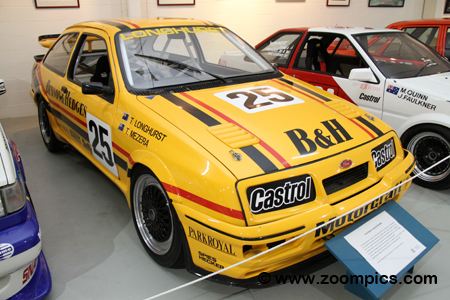
|
Pictured here is the 1988 Tooheys 1000 winning Ford Sierra Cosworth RS500 driven by the car owner, Tony Longhurst and Tomas Mezera.
In March 1987, Ford contracted Aston Martin to build the new Cosworth RS500.
By August of that year, 500-cars were homologated and ready for racing.
These cars featured a 2.0-liter turbocharged engine with an intercooler.
They were not only successful in Australia but won titles internationally.
|

|
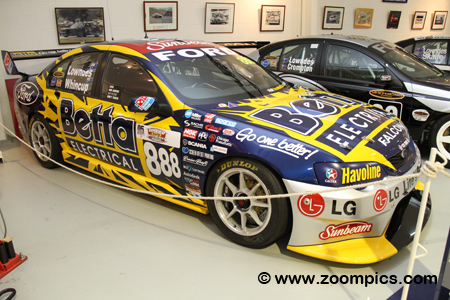
|
In 2006 this Ford Falcon BA ended Holden’s dominance of the Bathurst 1000.
Ford won its last at Mount Panorama race in 1998.
The winning Triple Eight Race Engineering Falcon was driven by Craig Lowndes and Jamie Whincup.
This was Whincup’s first Bathurst victory and the second for Lowndes.
It was also the first race since the death of the event’s nine-time winner, Peter Brock.
The top team was given the Peter Brock Trophy.
|

|
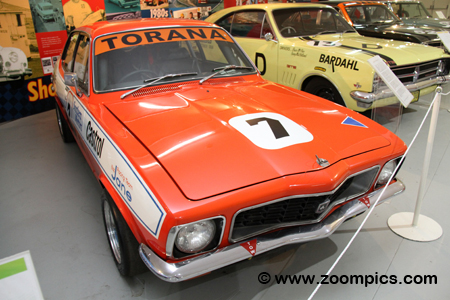
|
Australian Touring Car racing underwent some significant changes in 1973.
Cars competing in the Australian championship and the Hardie-Ferodo 1000 would use the same rules.
There were four classes – A through D – with cars being categorized based on engine displacement.
Finally, the length of the Great Race was doubled to 1000-kilometers.
On display from that year is a Holden LJ Torana GTR XU-1.
|

|
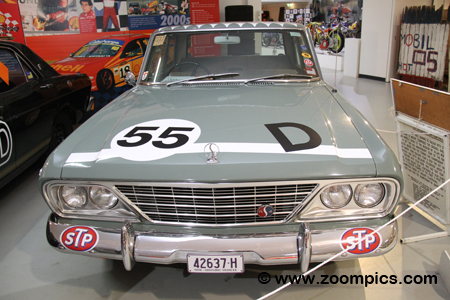
|
Studebaker produced a lot of successful cars between 1902 and 1966.
The model at the National Motor Sport Museum is a 1964 Studebaker Commander.
The Commander nameplate was first used in 1927 and retired from 1959 to 1963 before being reintroduced.
The No. 55 Commander was raced twice at Bathurst.
In 1967, Warren Weldon and John Hall finished eleventh overall and the following year, they were thirteenth.
|

|
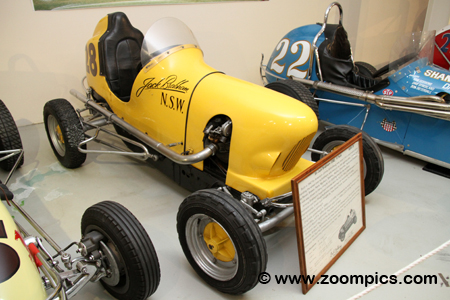
|
One of the best known Australian race drivers is Jack Brabham.
Brabham’s racing resume includes three Formula One World Championships.
In 1966, he became the first and only driver to win a World Championship in a car bearing his name.
This car was built in 1947 by Brabham for Johnny Schonberg.
When Schonberg retired the following year, Brabham inherited the ride and as they say, ‘the rest is history.’
|

|
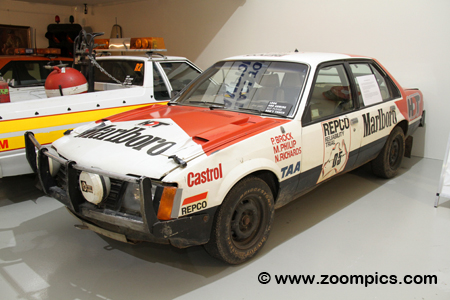
|
One-hundred and seventy-six teams started the 1979 Repco Reliability Trial, with ninety-two classified as finishers.
The car on display is the winning Holden Commodore VB.
The Holden’s used a six-cylinder engine but were equipped with V8 transmission and a 200-liter fuel tank.
The Marlboro Holden Dealer Team entered three cars.
The No. 05 Holden shared by Peter Brock, Matt Phillips and Noel Richards won the event.
|

|
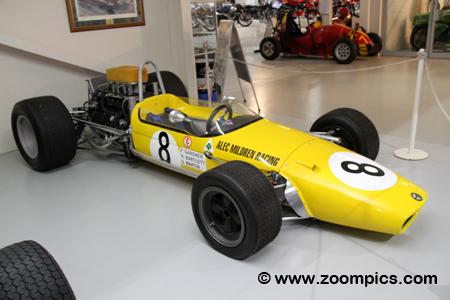
|
The first race for this 1967 Brabham BT23D was in December at Warwick Farms.
Driven by Frank Gardner, this Brabham lapped the field on the way to victory and in the process, broke Jackie Stewart’s lap record.
Constructed to rules for the Tasman series, the car was equipped with an Alfa Romeo engine prepared by Auto Delta.
The motor is a 2.5-liter alloy engine with four camshafts, which produced 320-horsepower at 9,300-rpm.
|

|
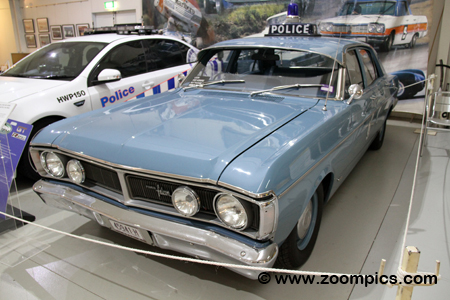
|
Also on display at the museum is this 1971 Ford XY Falcon 500 New South Wales Police Special Traffic Patrol Chaser.
There were 150 of these vehicles built for police forces in New South Wales, Victoria and the Australian Capital Territory.
This limited-edition Ford featured the Falcon T-code engine, transmission and limited-slip differential.
Also, unique to this car is a speedometer calibrated for 130-mph.
|

|
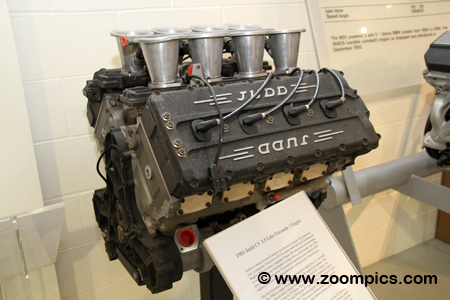
|
Engine Developments Limited is a company founded by John Judd and Australian, Jack Brabham.
Judd is the name of engines produced by the company.
The National Motor Sport Museum houses this 1983 Judd CV 3.5-liter Formula One motor.
March was the first team to use the Judd CV, followed by the Williams Team.
The engine continued to be used by smaller Formula One organizations until 1991.
|

|
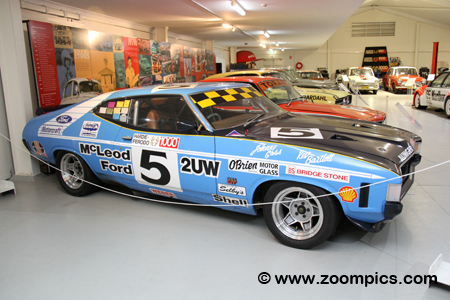
|
Kevin Bartlett and John Goss were successful open-wheel racers who captured the 1974 Hardie-Ferodo 1000.
Barlett was the 1968 and 1969 titleholder of the Australian Driver’s Championship and Goss was the winner
of the 1976 Australian Grand Prix. In 1974, they shared this Ford Falcon XA GT in what was called the wettest
race in the event’s history. The duo held on for the win, despite pressure from the Bob Forbes and Wayne Negus.
|

|
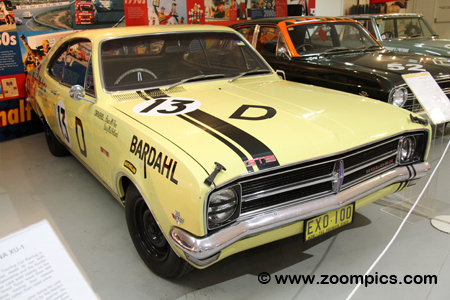
|
This 1968 Holden HK Monaro GTS 327 is a replica of the 1968 Hardie-Ferodo 500 winner.
After being thoroughly trounced by Ford at the 1967 event, Holden engineers went back to the drawing board.
The HK Monaro GTS is powered by Chevrolet’s 327-cu.in. V8 which produces 250-horsepower.
The car provided Holden with redemption as the top-three finishers were racing the new model.
|

|
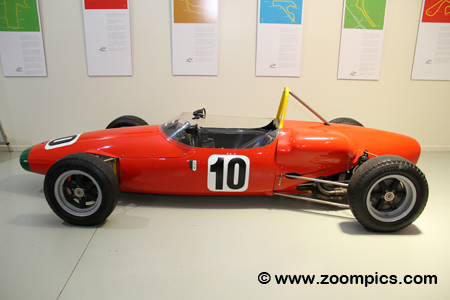
|
The Elfin Sports Car Company was founded by Garrie Cooper in 1957.
The company is the oldest continuous builder of race cars in Australia and has produced over two-hundred vehicles.
The model on display at the museum is a 1963 Elfin Formula Junior #6310 formally owned by Scuderia Veloce.
Between 1961 and 1964, the company built two different models of Formula Juniors with a production run of twenty cars.
|

|
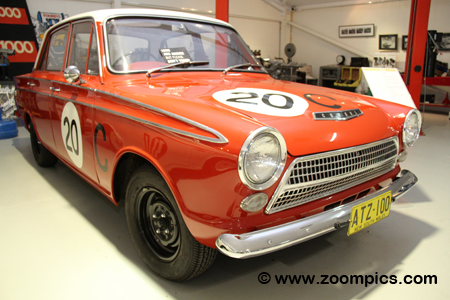
|
Another replica that received the full treatment from the Bathurst Council’s Workshop staff is this 1963
Ford Cortina MK 1 GT raced by Harry Firth and successful Australian businessman, Bob Jane.
The driving partners not only captured the class ‘C’ victory in the 1963 Armstrong 500 at Mount Panorama but
also grabbed the overall win. In fact, Firth and Jane lapped the field of fifty-eight starters.
|

|
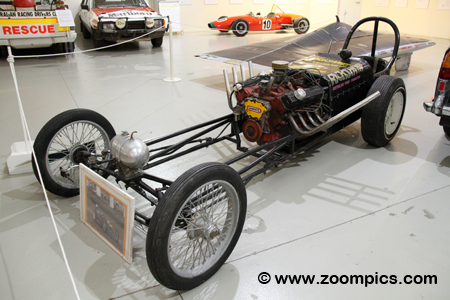
|
Named the ‘Rickshaw,’ this dragster was built in late the ‘50s by New South Wales native, Ray Wamsley.
As with many hot rods, this dragster is constructed with an array of parts from different vehicles – ’39
Ford manual transmission, ’37 Pontiac differential, a Morris front axle, MG TC hubs and powered by a British Alvis engine.
The car succeeded in setting the standing quarter-mile record in 1960. It was raced until the late ‘70s.
|

|
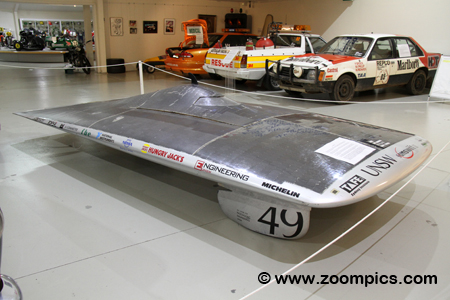
|
The Sunswift II was designed and built by students at the University of New South Wales (UNSW).
The UNSW Solar Racing Team constructed its first vehicle in 1997. Over the next seven years, the
students modified the vehicle to its present form. The solar panels on the Sunswift II produce 1.2kW,
enough power to toast a slice of bread. However, the design of the vehicle allows it to reach a speed of 130-Km/hr.
|

|
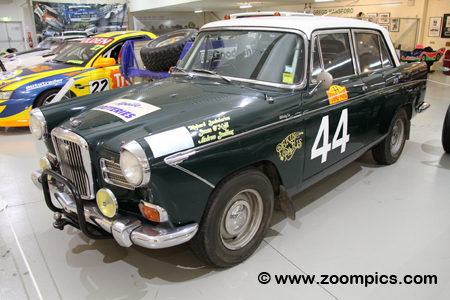
|
British motor vehicle manufacturer Wolseley Motors Limited was founded in 1901.
The company eventually joined British Leyland and in 1975, the last vehicle badged a Wolseley was produced.
The car on display is a 1965 Wolseley 24/80 Mark II. The 24/80 Mark II was powered by a 2.4-liter in-line six-cylinder engine,
which produced 80-horsepower. This car competed in the 1997 Peking to Paris rally for classic vehicles.
|

|
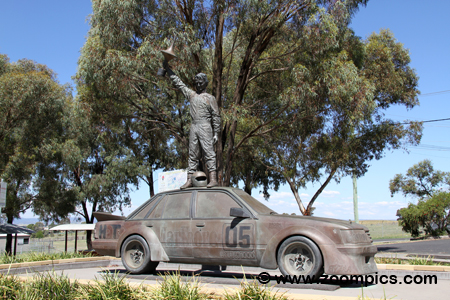
|
In front of the National Motor Sport Museum is a monument commemorating Peter Brock.
Brock was an Australian racing legend and known as ‘The King of the Mountain.’
His racing resume includes nine victories at the Bathurst 1000, nine wins in the Sandown 500 and three
Australian Touring Car Championships.
Brock was involved in many aspects of motor racing until he lost his life in the 2006 Targa West rally.
|
|
Copyright Notice:
|
All content (photographs and text) appearing on this website are the exclusive property of © www.zoompics.com and are protected under International copyright laws. The subject matter on this website may not be reproduced, copied, stored or manipulated.
|
© Copyright 1999, 2000, 2001, 2002, 2003, 2004, 2005, 2006, 2007, 2008, 2009, 2010, 2011, 2012, 2013, 2014, 2015,2016, 2017, 2018 and 2019


